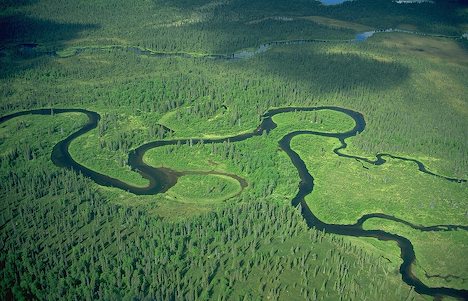* Please note: rivers and streams are interchangeable terms, they are not separate features. *
As they age, rivers change dramatically. Here are a few features that will help you determine the age of a river.
 |
| This is a young river due to its high elevation and V-shaped valley. |
Young Rivers:
- They typically form near drainage divides, areas where on watershed meets another. These divides are at high elevations.
- They typically form near drainage divides, areas where on watershed meets another. These divides are at high elevations.
- Young rivers have high gradients due to the fact that they have not had enough time to down cut (erode downwards) to base level.
- However, they want to get to base level, so there is a lot of downcutting.
- They have a high velocity due to their high gradients, and therefore erode much more than they deposit.
- The material at the banks of young rivers are very prone to mass wasting because of all the erosion from the stream.
- The river cuts a v-shaped valley as it erodes.
- Due to the high gradient and velocity, there are many rapids and waterfalls.
- Young rivers are generally very straight because there hasn’t been enough deposition to form meanders yet.
 |
| The Amazon River is a mature river because of its slight meanders and it has a few tributaries. |
Mature Rivers:
- This is the point in which the river is halfway between being young and old, so it has some features similar to an old river, and some similar to a young one.
- Mature rivers develope a small floodplain on either side of the channel due to deposition from flooding events
- It begins to form slight meanders as the deposition increases in some locations.
- A few tributaries may start to feed into a mature river.
- A mature stream is called a “graded stream” which means that the erosion and deposition are in balance
 |
| This river is old due to its large meanders, many tributaries, large floodplain, and meander scars. |
Old Rivers:
- In old rivers, there are very large meanders that have formed by the deposition and erosion over time.
- Features such as oxbow lakes and meander scars are present, showing that the river has changed course.
- There is a large floodplain, formed by many flooding events.
- It has a very low gradient since the mouth will have reached nearly base level from all the downcutting earlier in its life.
- Since the gradient is low, old streams have low velocities as well.
- Because the velocity is low, there is more deposition since the water doesn’t have the energy to carry the sediment.
By looking at the river and identifying its various features, it is relatively easy to determine a river’s relative age.
Have a fantastic day!
Image Citations:
Old, meandering river. Digital image. Geocaching. Groundspeak, Inc., 22 July 2010. Web. 27 May 2013. <http://img.geocaching.com/cache/5f2f82d5-11a4-44ef-9f00-f22f5ef0f0c2.jpg>.
Young River. Digital image. Geonet. N.p., 2 Oct. 2007. Web. 30 May 2013. <http://info.geonet.org.nz/download/attachments/951751/young-river-30-09-2007-3.jpg>.
Young River. Digital image. Geonet. N.p., 2 Oct. 2007. Web. 30 May 2013. <http://info.geonet.org.nz/download/attachments/951751/young-river-30-09-2007-3.jpg>.
UC Berkeley. Amazon River. Digital image. Treehugger. MNN Holdings, LLC, 8 Feb. 2010. Web. 27 May 2013. <http://media.treehugger.com/assets/images/2011/10/amazon-river-hydropiracy.jpg>

Hello
ReplyDeletehey
ReplyDeletesup
ReplyDeletewASSup
ReplyDelete